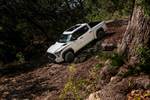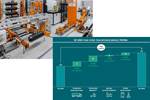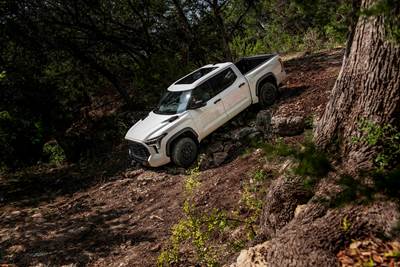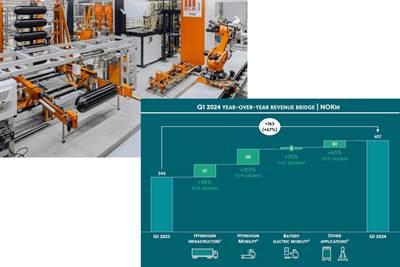Hexagon Purus to supply hydrogen storage to Toyota Motors North America
Hydrogen storage and high-voltage battery system to support Class 8 heavy-duty fuel cell powertrains developed by Toyota.
Hexagon Purus hydrogen storage system (left) and zero-emission fuel cell electric vehicle (FCEV) drayage truck is delivering new incoming vehicles from Toyota Logistics Services (TLS) at the Port of Long Beach, California. Source | Hexagon Purus and Toyota Motors North America (TNMA)
Hexagon Purus (Oslo, Norway) will supply components — including a full hydrogen (H2) storage system and high-voltage battery pack — to Toyota Motors North America (TMNA) for serial production of its heavy-duty fuel cell electric powertrain kits.
Hexagon Purus’s collaboration with the company started in 2017 as Toyota began development of the fuel cell electric powertrain kits for Class 8 trucks, including the proof of concept “Alpha” truck for the Port of Los Angeles, supporting the port’s efforts to reduce harmful emissions. Hexagon Purus also supported the H2-powered heavy-duty fuel cell electric truck powertrain employed in the “Ocean” trucks used in the ZANZEFF “Shore to Store” program (2020).
“We are entering a new era in our collaboration with Toyota supplying components for its fuel cell powertrain kits, to help pave the way for zero emission commercial transportation,” says Todd Sloan, executive vice president of battery systems and vehicle integration at Hexagon Purus. “Hydrogen can play a significant role in the reduction of emissions from heavy-duty transportation.”
Toyota Motor Manufacturing Kentucky (TMMK) assembles integrated dual fuel cell modules for use in H2-powered heavy-duty commercial trucks. The fuel cell kit, including the battery and H2 storage systems supplied by Hexagon Purus, will be sold to heavy-duty truck OEMs for fuel cell electric vehicle (FCEV) Class 8 trucks.
Toyota notes that it has been granted a zero-emission powertrain (ZEP) Executive Order from the California Air Resources Board (CARB) for the new heavy-duty fuel cell electric powertrain. The certification helps heavy-duty Class 8 commercial truck OEMs and operators comply with increasingly strict emissions regulations in the state of California.
To reach the 1.5°C ambition set by the 2015 Paris agreement, the transportation sector is required to reduce emissions by 75% by 2050. In the U.S., both Environmental Protection Agency (EPA) and CARB have introduced proposals and regulations that address the need for further reductions in emissions in the transportation sector.
Notably, there are approximately 1.8 million commercial trucks operating in California daily across a various set of classes including among other 219,000 Class 7 and 8 trucks. According to CARB, the combined effect from the ACT and Advanced Clean Fleet (ACF) regulations will lead to approximately 0.5 million zero-emission vehicles (ZEVs) on the road by 2035 in California, increasing to 1.6 million in 2050.
ZEV drayage trucks, Tri-gen solution
Toyota’s ZEV powertrains for Class 8 tracks are already providing a solution for ports in California. As of Jan. 1, 2024, the ACF regulation will only allow zero-emission trucks to newly register as drayage trucks. By 2035, all drayage trucks will be required to be zero emissions.
Toyota and partner FuelCell Energy Inc. (Danbury, Conn., U.S.) celebrated the opening of the Tri-gen system at the Toyota Logistics Services (TLS) distribution center at the Port of Long Beach, California on May 2, 2024.
In January 2024, Toyota used the renewable H2 produced at Tri-gen to fill the first Toyota Mirai passenger cars at TLS, and in April, heavy-duty FCEV Kenworth T680 Class 8 truck was filled at the adjacent Shell HD filling station using Tri-gen-produced renewable hydrogen. “This facility shows that there are ways to reduce our emissions and burden on natural resources with scalable technology based on hydrogen,” says Tom Stricker, group vice president of sustainability and regulatory affairs at Toyota.
The Tri-gen platform currently supports FCEV Class 8 trucks and is there to support on-going migration to zero-emission trucks between now and 2035.
Tri-gen is expected to help eliminate more than 9,000 tons of CO2 emissions from the power grid each year. It will also help avoid more than six tons of grid NOx emissions. Further, using H2-powered fuel cell Class 8 trucks in port operations can potentially reduce diesel consumption by more than 420,000 gallons per year.
“Tri-gen demonstrates that hydrogen-based energy can benefit businesses, deliver zero-emission transportation for light- and heavy-duty vehicles, support improved air quality in local communities, reduce water usage and deliver immediate and long-term benefits to the environment,” says Jason Few, CEO and president of FuelCell Energy Inc.
Related Content
Plant tour: Joby Aviation, Marina, Calif., U.S.
As the advanced air mobility market begins to take shape, market leader Joby Aviation works to industrialize composites manufacturing for its first-generation, composites-intensive, all-electric air taxi.
Read MoreThermoplastic composites: Cracking the horizontal body panel nut
Versatile sandwich panel technology solves decades-long exterior automotive challenge.
Read MoreCryo-compressed hydrogen, the best solution for storage and refueling stations?
Cryomotive’s CRYOGAS solution claims the highest storage density, lowest refueling cost and widest operating range without H2 losses while using one-fifth the carbon fiber required in compressed gas tanks.
Read MoreJeep all-composite roof receivers achieve steel performance at low mass
Ultrashort carbon fiber/PPA replaces steel on rooftop brackets to hold Jeep soft tops, hardtops.
Read MoreRead Next
Seat frame demonstrates next-generation autocomposites design
Light weight, simplified/cost-effective manufacturing, passenger comfort and safety informed materials and process innovations and won awards for the 2022 Toyota Tundra‘s second-row seat frame.
Read MoreHexagon Purus reports all-time high quarterly revenue, up 67% over Q1 2023
Type 4 CFRP cylinder manufacturer continues ramp-up, with H2 infrastructure up 38% and H2 mobility up 213% year over year while momentum continues in aerospace applications.
Read MorePlant tour: Daher Shap’in TechCenter and composites production plant, Saint-Aignan-de-Grandlieu, France
Co-located R&D and production advance OOA thermosets, thermoplastics, welding, recycling and digital technologies for faster processing and certification of lighter, more sustainable composites.
Read More

























